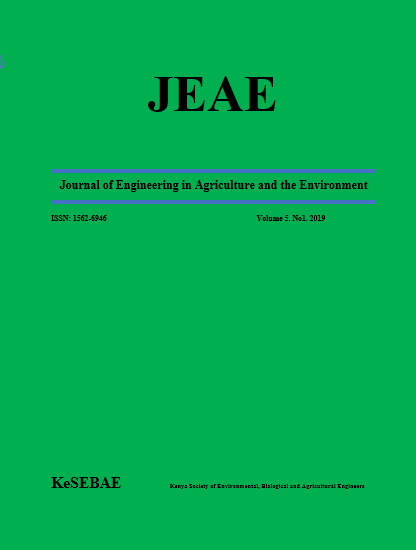Abstract
Cassava is produced in Kenya mainly as subsistence and is the second most important food crop after maize in the Country’s Western and Coastal regions. Its production and use as human food, animal feed and industrial starch is low due to poor agronomic practices postharvest handling and processing, bulkiness and low application of mechanised operations to scale production to commercial levels. An average yield of 15.3 MT/ha on 0.2 to 1 ha household units was realised against a potential of 90 MT/ha in 2014 producing 935,089 MT of cassava valued at $ 168 million. Kenya is a low mechanized country with a mechanical power usage indicated at 30%, hand power at 50%, and animal draught power at 20%. Mechanisation models that apply a systems approach by taking into account the value chain cycle is muted as feasible a pathway for ascertaining the technical and economic sustainability of the cassava enterprise in the country. Commercialization of the cassava value chain requires household production at scales beyond 4 ha. Such scales require mechanised production and primary processing for technical feasibility. A system that will provide mechanised tillage, planting, weeding, harvesting and processing through organised delivery and technical back up support is projected as the best entry to address this limitation. This would unleash the commercial viability of the cassava value chain and grow the livelihood system of producers and processors beyond subsistence thresholds.
References
KENFAP Services Limited. 2013. Reintroduction and commercialization of cassava for improved livelihoods through whole value chain model: Ganze cassava value chain report. CAST NGO, Kilifi.
Osipina, B., Cadavid, L.F., Garcia, M., Alcalde C.
Mechanization of cassava production in Colombia.CLAYUCA (Latin American and Caribbean Consortium to Support Cassava Research and Development), Valle del Cauca, Colombia.
Munga, T.L., Maina, F., Sila, M.M. 2012. Socioeconomic status of cassava production in major cassava growing districts in western, eastern, and coastal regions in Kenya.A baseline survey
report. East African Agricultural Productivity Programme (EAAPP), Nairobi.
FAO. 2013. Save and Grow: Cassava; A guide to sustainable cassava production intensification, FAO, Rome.
GoK. 2007, National Policy on Cassava Industry, Industry and Policy reforms to improve production, research, marketing and regulations in the Cassava Industry.
KIPPRA. 2016. Kenya Economic Review Report 2016.
Mwango’mbe, A.W., Mbugua, S.K., Olubayo, F.O., Ngugi, E.K., Mwinga, R., Munga, T., Muiru, W.M. 2013. Challenges and Opportunities in Cassava Production among the Rural
Households in Kilifi County in the Coastal Region of Kenya; Journal of Biology, Agriculture and Healthcare, 3(10).
Monk, K. 2015. An economic analysis of a mechanized systems approach to cassava production in Sub-Saharan Africa, MSc Thesis, University of Illinois at Urbana-Champaign,
Bosrotsi, C. K., A. Addo, K. A. Dzisi, S. K. Agodzo . 2017. Technical Performance and Economic Feasibility Assessment of A Mechanical Yam
Harvester; International Journal of Research
Studies in Agricultural Sciences (IJRSAS); 3(3), 1-10.
Isaac, N Itodo, Joakim O Daudu. 2013. Performance evaluation of a tractor mounted yam harvester fitted with a collection unit. American Society of Agricultural and Biological Engineers, St. Joseph, Michigan www.asabe.org
Shadrack Kwadwo Amponsah, Joseph Nketiah Berchie, Joseph Manu Aduening, Eric Owusu Danquah, Jonas Osei Adu, Adelaide Agyeman and Enoch Bessah. 2017.
Performance of an improved manual cassava harvesting tool as influenced by planting position and cassava variety. African Journal of Agricultural Research, 12(5), 309 -319.

This work is licensed under a Creative Commons Attribution 4.0 International License.
